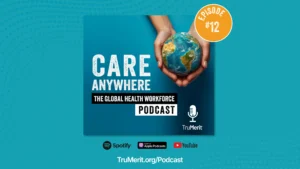The Future of Remote Patient Monitoring with Digital Medicine Society
The Digital Medicine Society (DiMe) is a global nonprofit specializing in the advancement of ethical, effective, equitable, and safe use of digital technology for redefining healthcare and optimizing lives. Jennifer Goldsack, CEO of DiMe, spoke with Intel’s Head of Global Health Solutions Alex Flores on the advancements in remote patient monitoring and the role technology plays in this.
Remote patient monitoring allows parsing out different digital phenotypes within certain disease states to effectively match treatment with the patient. Goldsack says, “In those broad disease states, where there’s very little that we can do to either ameliorate symptoms of the disease or cure the disease — something like Parkinson’s or Alzheimer’s disease. We’re hopeful that these new measures can start to advance the field.”
Goldsack believes there is a much more practical reason for remote patient monitoring to become an essential focus of care: the evolving role and methods of healthcare today.
“We must start thinking about how we can start to monitor people’s health outside the clinic walls,” she explains. “How can we think about patients with complex chronic diseases who may have episodic conditions with flare-ups? How can we monitor their well-being and health performance under clinicians’ care without bringing them into the hospital every time?”
The reality that healthcare presently faces is a shortage of doctors and clinicians to treat the number of patients. Remote patient care is one healthcare solution that helps ensure the patient gets the best care possible, even with reduced resources available. “We can use remote patient monitoring to get early signals… [and] we can intervene and care for them before those outcomes become bad and before they become pricey,” Goldsack says.
The technology behind remote patient monitoring must be high quality to make high-quality clinical decisions. Clinical validation of the gathered data is vital in this process. Goldsack says it’s also crucial that the technology deployed is an affordable solution, because if it isn’t, then it won’t be sustainable.
In terms of utilizing AI in the remote patient monitoring process, Goldsack says there is unlimited potential. Still, it is important to keep things in perspective and focus on the most critical challenges first. “We should look at the ability to identify particular phenotypes within large population-level data sets,” she notes. “AI might be able to tell us if we deliver the right data that some patients do well, and for whatever reasons, some patients end up having a fall and an injury and come back into the hospital within four weeks. It might be that we have no idea what the differences are between those patients who fall and those who don’t.” AI could help make those determinations.
Learn more about remote patient monitoring by connecting with Jennifer Goldsack or Alex Flores on LinkedIn or visit:
Subscribe to this channel on Apple Podcasts, Spotify, and Google Podcasts to hear more from the Intel Health and Life Sciences at the Edge.









